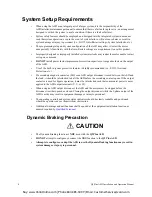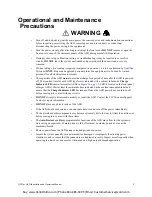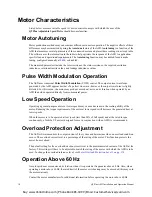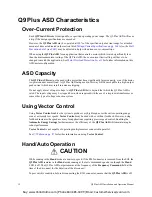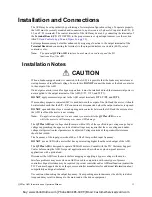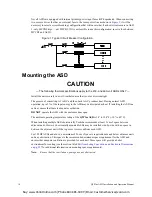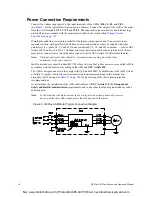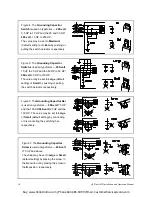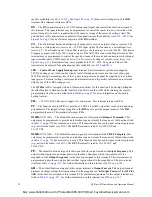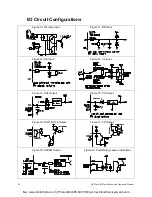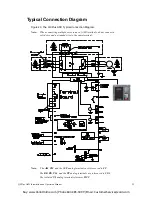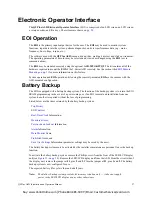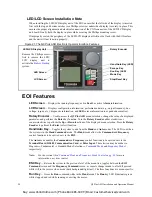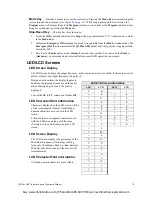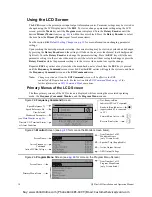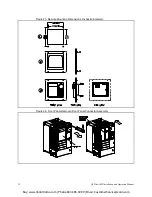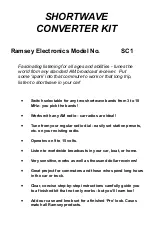
Q9 Plus ASD Installation and Operation Manual
21
Terminal Descriptions
Note:
The programmable terminal assignments may be accessed and changed from their
default settings as mapped on
pg. 46
or via the
Direct Access
method: Program
Direct Access
Applicable Parameter Number
. See the section titled
Program
Mode Menu Navigation on pg. 46
for the applicable
Direct Access
parameter
numbers.
Note:
For further information on terminal assignments and default setting changes, see the
sections titled
Default Setting Changes on pg. 35
and
Input Terminals on pg. 50
.
Note:
See the section titled
Cable/Terminal Specifications on pg. 266
for the
Q9 Plus ASD
conductor and terminal electrical specifications.
ST
— The default setting for this terminal is the
Standby
mode controller. As the default setting, this
terminal must be activated for normal system operation. The
ST
terminal is activated by connecting
CC
to this terminal (Sink mode). When deactivated,
OFF
is displayed on the
Frequency
Command
screen. This input terminal may be programmed to any of the functions listed in
Table 10 on pg. 234
(see
F113
).
RES
— The default setting for this terminal is
Reset
. The
RES
terminal is activated by connecting
CC
to this terminal (Sink mode). A momentary connection to
CC
resets the ASD and any fault indications
from the display.
Reset
is effective when faulted only. This input terminal may be programmed to any
of the functions listed in
Table 10 on pg. 234
(see
F114
).
F
— The default setting for this terminal is
Forward
run command. The
F
terminal is activated by
connecting
CC
to this terminal (Sink mode). This input terminal may be programmed to any of the
functions listed in
Table 10 on pg. 234
(see
F111
).
R
— The default setting for this terminal is
Reverse
run command. The
R
terminal is activated by
connecting
CC
to this terminal (Sink mode). This input terminal may be programmed to any of the
functions listed in
Table 10 on pg. 234
(see
F112
).
S1
— The default setting for this terminal is
Fire Speed
. The function of this input as
Fire Speed
is to
run the motor at the
Preset Speed 1
setting upon activation. This terminal may be activated by
connecting
CC
to this terminal (Sink mode) and may be initiated by a fire alarm signal or fire/smoke
sensing device. This input terminal may be programmed to any of the functions listed in
Table 10 on
pg. 234
(see
F115
).
S2
— The default setting for this terminal is
Preset Speed 2
. The function of this input as
Preset Speed 2
is to run the motor at the
Preset Speed 2
setting upon activation. The terminal may be
activated by connecting
CC
to this terminal (Sink mode). This input terminal may be programmed to
any of the functions listed in
Table 10 on pg. 234
(see
F116
).
S3
— The default setting for this terminal is
Damper Feedback
. The function of this input as Damper
Feedback is to complete the requirements for normal system operation as described in
Table 10 on
pg. 234
. The S3 terminal is activated by connecting CC to this terminal (Sink mode). This input
terminal may be programmed to any of the functions listed in
Table 10 on pg. 234
(see
F117
).
S4
—
The default setting for this terminal is
Emergency Off
(Normally Closed). The
Emergency Off
terminal is activated by opening the connection to
CC
(Sink mode). The function of this input as
Emergency Off
is to remove power from the output of the ASD and may apply a supplemental braking
system using the method selected at the
Emergency Off Mode
selection parameter (see
F603
). This
input terminal may be programmed to any of the functions listed in
Table 10 on pg. 234
(see
F118
).
RR
— The default function assigned to this terminal is the
Frequency Mode 1
setting. The
RR
terminal
accepts
a 0 – 10 VDC input signal that is used to control the function assigned to this terminal.
This input terminal may be programmed to control the speed or torque of the motor via an amplitude
setting or regulate by setting a limit. The gain and bias of this terminal may be adjusted for application-
Buy: www.ValinOnline.com | Phone 844-385-3099 | Email: CustomerService@valin.com


